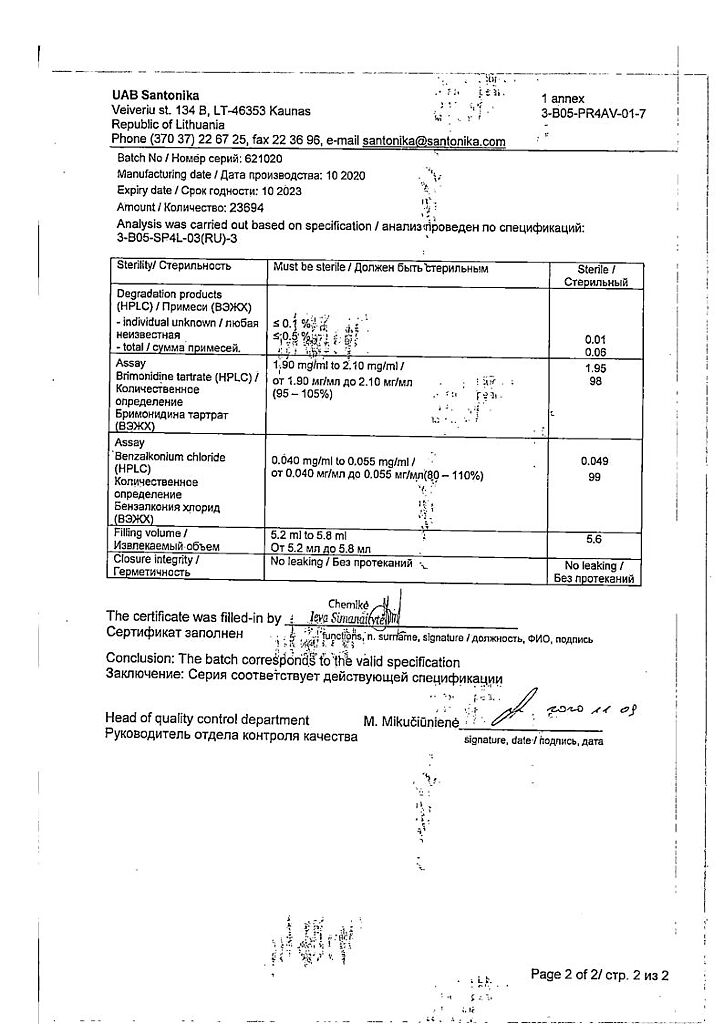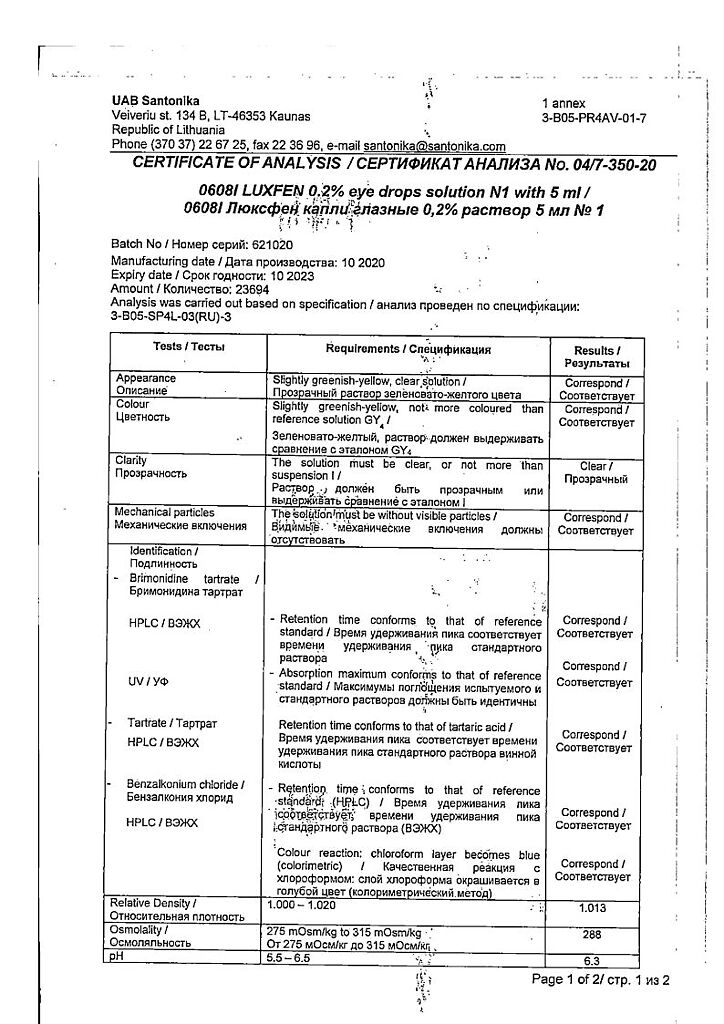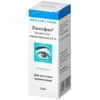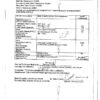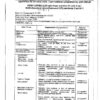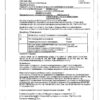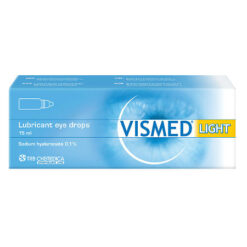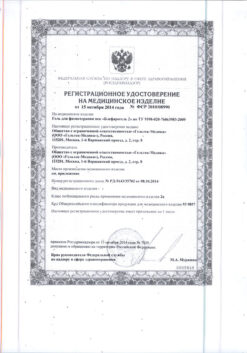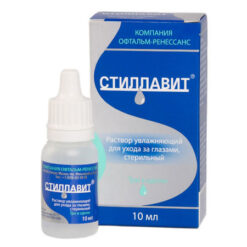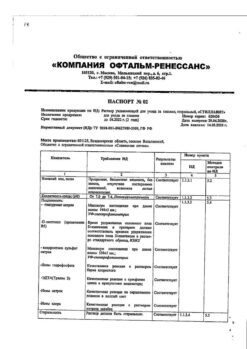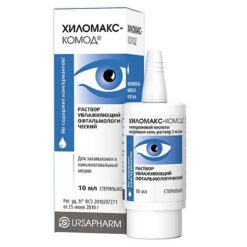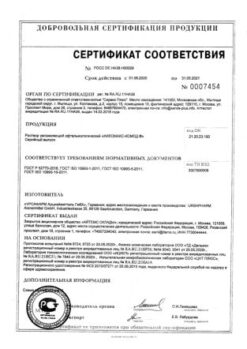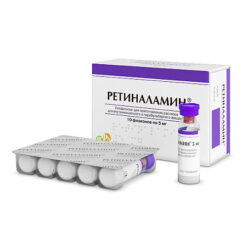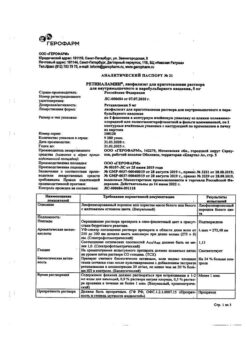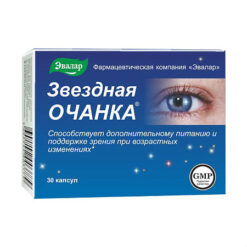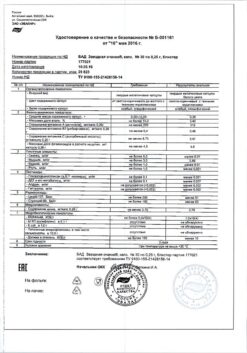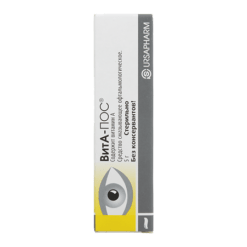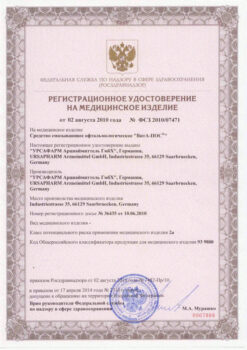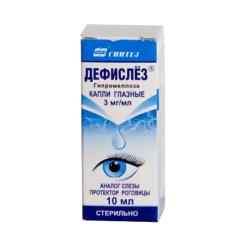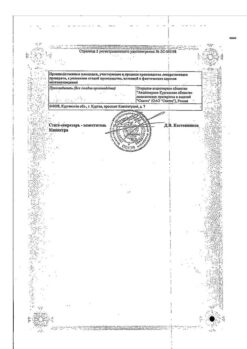No products in the cart.
Luxphene, eye drops 0.2% 5 ml
€1.00
Out of stock
(E-mail when Stock is available)
Description
Brimonidine is a selective α2-adrenoreceptor agonist.
In instillation of 0.2% brimonidine solution decreases intraocular pressure by 10-12 mm Hg with a maximum effect after 2 hours and duration of action of 12 hours.
Brimonidine has a double mechanism of action: it decreases the intraocular pressure by reducing the synthesis of the intraocular fluid and increasing the uveoscleral outflow.
Pharmacokinetics
In instillation of eye drops, Cmax of the drug in blood plasma is reached after 0.5-2.5 hours. Binding to blood proteins when administered locally is 29%. Systemic absorption of brimonidine is delayed. After using the drug 2 times per day for 10 days the plasma concentration of brimonidine is still low (0.06 ng/ml on average).
The drug is metabolized mainly in the liver. Brimonidine and its metabolites are excreted by the kidneys. T1/2 is about 2 h.
Indications
Indications
Open angle glaucoma,
ocular hypertension (in monotherapy and in combination with other drugs that reduce intraocular pressure).
Pharmacological effect
Pharmacological effect
Brimonidine is a selective α2-adrenergic receptor agonist.
When instilling a 0.2% brimonidine solution, the decrease in intraocular pressure is 10-12 mmHg. Art., the maximum effect is observed after 2 hours, duration of action is 12 hours.
Brimonidine has a dual mechanism of action: it lowers intraocular pressure by reducing the synthesis of intraocular fluid and increasing uveoscleral outflow.
Pharmacokinetics
When instilled with eye drops, Cmax of the drug in the blood plasma is achieved after 0.5-2.5 hours. Binding to blood proteins when applied topically is 29%. Systemic absorption of brimonidine is slowed down. After using the drug 2 times a day for 10 days, the plasma concentration of brimonidine remains low (on average 0.06 ng/ml).
The drug is metabolized primarily in the liver. Brimonidine and its metabolites are excreted by the kidneys. T1/2 is about 2 hours.
Special instructions
Special instructions
Contact lenses should be removed before using the drug. The time interval between using the drug and re-inserting contact lenses should be at least 15 minutes.
Impact on the ability to drive vehicles and other mechanisms that require increased concentration
The drug may cause fatigue or drowsiness, decreased vision clarity, so during treatment with the drug you should refrain from driving vehicles and servicing moving machinery.
Active ingredient
Active ingredient
Brimonidine
Composition
Composition
1 ml – brimonidine tartrate 2 mg.
Excipients:
benzalkonium chloride – 0.052 mg,
polyvinyl alcohol – 14 mg,
sodium chloride – 6.9 mg,
sodium citrate dihydrate – 4.7 mg,
citric acid monohydrate – 0.48 mg,
hydrochloric acid – up to pH 6.45,
sodium hydroxide – up to pH 6.45,
water – up to 1 ml.
Contraindications
Contraindications
Hypersensitivity to the components of the drug;
simultaneous therapy with monoamine oxidase inhibitors (MAO) and tricyclic antidepressants;
children under 2 years of age;
breastfeeding period.
With caution: when using the drug in patients with severe, unstable and uncontrolled form of cardiovascular disease, with cerebral or coronary insufficiency, depression, orthostatic hypotension, Raynaud’s disease, thromboangiitis obliterans; with impaired liver or kidney function; children’s age from 2 to 18 years.
Side Effects
Side Effects
The incidence of side effects is classified as follows: very often (>1/10), often (from >1/100 to 1/1000 to 1/10,000 to
From the side of the organs of vision:
very often – allergic conjunctivitis, conjunctival hyperemia, itching of the skin of the eyelids and mucous membrane of the eyes;
often – a burning sensation; folliculosis of the conjunctiva of the eyes and follicular conjunctivitis, local allergic reactions of the mucous membrane of the eyes (including keratoconjunctivitis); blepharitis, blepharoconjunctivitis, impaired clarity of visual perception, cataracts, conjunctival edema, conjunctival hemorrhage, conjunctivitis, retention lacrimation, mucous discharge from the eyes, dryness and irritation of the mucous membrane of the eyes, pain, swelling of the eyelids, redness of the eyelids, sensation of a foreign body in the eyes, keratitis, damage to the eyelids, photosensitivity, superficial, spotted keratopathy, lacrimation, loss of visual field, functional damage to the vitreous, vitreous hemorrhage, vitreous floaters and decreased visual acuity;
infrequently – corneal erosion, barley.
From the central nervous system:
often – headache, drowsiness, insomnia, dizziness.
From the cardiovascular system:
often – increased blood pressure;
infrequently – decreased blood pressure.
From the respiratory system:
often – bronchitis, cough, shortness of breath;
uncommon – dry nasal mucosa, apnea.
From the gastrointestinal tract:
often – gastrointestinal disorders – dyspepsia, dry oral mucosa
For the skin and subcutaneous fat:
often – rashes.
Infectious and parasitic diseases:
often – flu-like syndrome, infectious disease (chills and respiratory infection), rhinitis, sinusitis, including infectious.
Laboratory indicators:
often – hypercholesterolemia.
Other:
often – general allergic reactions, asthenia, fatigue;
infrequently – changes in taste sensations.
In children, the following were noted: apnea, bradycardia, decreased blood pressure, hypothermia, muscle hypotension.
Additionally, data on the following effects were obtained:
On the part of the visual organs: frequency unknown – iritis, keratoconjunctivitis, miosis.
From the central nervous system: depression.
From the cardiovascular system: bradycardia, tachycardia.
From the gastrointestinal tract: nausea.
From the skin and subcutaneous fat: local skin reactions (erythema, itching, swelling of the face, rash and vasodilation of blood vessels in the skin of the eyelids).
Interaction
Interaction
Brimonidine at a concentration of 2 mg/ml may enhance the effects of substances that affect the central nervous system (alcohol, barbiturates, opioids, sedatives and anesthetics). Caution should be exercised when taking drugs that can affect the absorption into the blood and metabolization of adrenaline, norepinephrine and other so-called biogenic amines (chlorpromazine, methylphenidate, reserpine).
Some patients experience a slight decrease in blood pressure after using brimonidine solution at a concentration of 2 mg/ml. Caution should be exercised when used simultaneously with antihypertensive drugs and/or drugs from the group of cardiac glycosides (digitalis).
When coadministering systemic adrenergic agonists or antagonists (e.g., isoprenaline or prazosin) for the first time, or when changing the dose of these concomitantly administered systemic drugs (regardless of route of administration), interactions with or interference with alpha-adrenergic agonists may occur.
Overdose
Overdose
If the drug is accidentally taken orally, the following symptoms are possible: depression of the central nervous system, drowsiness, depression and loss of consciousness, decreased blood pressure, bradycardia, decreased body temperature, cyanosis of the skin, apnea.
In case of accidental ingestion of the drug: supportive symptomatic therapy, control of airway patency.
Storage conditions
Storage conditions
Store out of the reach of children at a temperature not exceeding 25 ºС.
Shelf life
Shelf life
2 years, after opening the bottle – 4 weeks.
Manufacturer
Manufacturer
Santonika, Lithuania
Additional information
| Shelf life | 2 years, after opening the bottle – 4 weeks. |
|---|---|
| Conditions of storage | Keep out of reach of children at a temperature not exceeding 25 ºC. |
| Manufacturer | Santonica, Lithuania |
| Medication form | eye drops |
| Brand | Santonica |
Related products
Buy Luxphene, eye drops 0.2% 5 ml with delivery to USA, UK, Europe and over 120 other countries.


